Lots has been written about the Skymax 180 PRO Pro and it's a
scope you will either love or hate. On its release it was almost universally
condemned for its many supposed faults. These included the long cool down time
and the fact that it was seen as very much a one trick pony. Many nay sayers
were even convinced that Skywatcher could never produce a high quality Maksutov
!!!
This review is my own experience from using the scope for a few
years and how I came to love this gem of a telescope from Skywatcher.
Background
Mine was acquired second
hand for the good price of £300. Its previous owner found it too
difficult to use for astro-imaging because of its long focal length at f15 and
too much of a handful in weight and it is indeed a heavy scope weighing in at
around 9kg for the tube only. Add to that its supplied diagonal and finder and
you have a weight of around 10kg. Throw away the dreadful accessories and put a
few extras on and the scope can easily start to top the scales at 13kg or
more.
The unit was originally acquired as a present for my sister but she
too found it too heavy and too awkward to use and found it 'unlucky'. And so it
fell to me to be its final owner and perhaps the first to really exploit this
particular units potential after a long love hate
relationship.
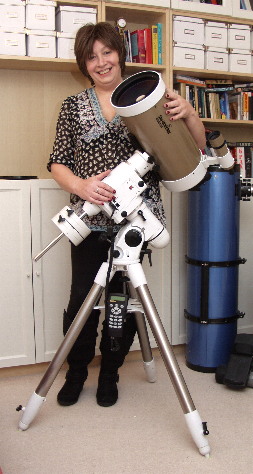 |
The Skymax 180 on an EQ6 mount.
Maksutovs have a reputation
for compactness but larger ones like the 180 PRO can be quite a bit bigger than
you may think ! |
|
Hardware
The scope was supplied with its original extras which
were rather disappointing given the scopes 'Pro' status. The OTA is beautifully
made, very heavy and solid. Mine showed no defects at all. The accessories are
something else........
The diagonal was
appallingly bad being just about the cheapest and nastiest diagonal imaginable.
The supplied eyepieces were a 9mm and a 20mm LET eyepiece which are not
Skywatchers finest by any means. The finder is the fairly standard Skywatcher
8x50 straight through finder which is standard on most of Skywatchers range and
is basic but good.
Why Skywatcher choose to ship
such a finely engineered telescope with such poor accessories like the cheap
diagonal is anyones guess. To my mind it should either have been supplied with
high quality extras or none at all. Newer models are in fact shipped with a
better quality 2" diagonal and a 28mm LET eyepiece.
One small
headache with the Skymax 180 PRO was that the finder could not be bought into
collimation with the main scope optics. The reason for this is that the finder
shoe is mounted on the gently sloping rear casing of the telescope and as a
result the finder is tilted very slightly - enough so that its adjusters cannot
bring it into collimation with the main scope. I have heard other Skymax owners
complain about this. Its easy to fix with either a paper shim on the finder
shoe or simply remove the finder shoe from the scope and file it down. Don't
worry about this because there are no bolts to fall down inside the scope. The
threads for the accessory shoe are cut into the scopes rear plate.
The focuser on my scope was a model of smoothness with enough
friction to give it a good feel. I have found some Mak/SCTs tend to have far
too loose a focuser and lack any feeling at all. |
|
My first upgrade
to the scope, even before first light, was to sell off the dreadful diagonal
and the LET eyepieces. The LETs are passable enough for a starter set but I
already had EPs of better quality. This reduced the overall price of the
telescope for me. Mine was planned to be used with my TAL diagonal which is
superb while the eyepieces would be a mix of Hyperions and TMB Planetary II
types in my possession at the time of the scopes acquisition. These were later
changed for UO Orthoscopics and Pentax XWs.
The
'Golden Jinx'
My sister had complained that the Skymax 180 PRO
had proven to be "unlucky" and claimed that every time it was bought out for
use the sky went cloudy. I owned the Skymax 180 PRO for almost 14 months before
it was given its first light due to the same problems and it did seem at times
to be a cursed instrument.
Like my sister I found the
Skymax to be an 'unlucky' scope for weather. During these 14 months I also had
a Rumak type telescope on evaluation and it never once got a good sky. The
Rumak was an alternative and I had promised the vendor that I would test the
two scopes and make my choice. The weather was so atrocious for so long and the
few good spells were always at times when it wasn't possible to observe for one
reason or another. In the end the Rumak was sent back and I was stuck once
again with the Skymax which came to be called 'The Golden
Jinx'.
I was hampered in part because
the accepted wisdom was that the big Maksutov would require at least three
hours to cool down to ambient temperature when taken outside. This in part led
to the scope never really getting a fair turn. As someone who is mobile and
lives in a flat the scope was always passed over in favor of other scopes as I
seldom had enough time to let a scope cool for 3 hours prior to
use.
First light for the 180 came at the Salisbury Star Party in 2010 and
once again the scopes very own jinx appeared with a vengeance. On the first
night the mount broke down. The second night was cloudy and the final night the
dew was so bad that I couldn't keep the optics clear long enough to ever get a
view and form an opinion. After the Salisbury Star Party I was sorely tempted
to sell the 180 and felt that perhaps this was a scope that would never be of
use to me.
I did at one point sell the scope only to have the buyer
back out. This would turn out to be the best luck of all....... though it
didn't seem it at the time !
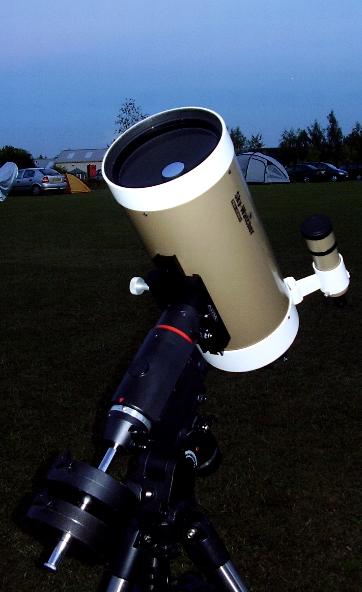 |
The Skymax 180 Pro at
Salisbury on the HEQ5.
The scope was to have a truly jinxed time at the
Star Party. |
|
Nth Light or Thereabouts
After endless set backs with weather I
finally got to use the Skymax 180 in Winter 2010 and it showed enough mettle to
make me believe it could be a real planet killer.
After having bought a heated
dew shield and dew controller to keep the optics dry (which is essential with
this scope as it really can be a dew magnet) I finally resolved to get at least
one view from it before I ran out of patience and sold it.
Its first real
light was with the moon full and extra ordinarily bright and crisp conditions
so the seeing was far from perfect but lunar detail was astounding at even low
power magnification. The 180 was thoroughly cooled down and the air was
extremely cold and stable. I could well believe on lunar work on a partial moon
the view might well be mind-blowing.
Saturn came up late in the
evening and the scope had reached thermal equilibrium some time before so was
totally free of any nasty tube currents. Unfortunately by the time Saturn appeared the sky was showing faint
traces of wispy high altitude cloud. None the less the scope rendered an
extremely large and very sharp view of the ringed wonder and enough was seen to
be convinced to allow the scope a reprieve from the 'for sale' ads.
So the first night where the scope could actually be used turned out
to be a mere teaser of what the scope might be capable of. |
|
Awakening
Multiple uses of the Skymax 180
PRO over the following months created an awakening in the nature of a religious
conversion. The scope was used progressively more and more and it became
obvious that the supposed three hour cool down time was grossly overstated. In
reality even from a warm flat into the near zero night air the scope seldom
needed more than 90 minutes. Even after 20 minutes the scope would prove to be
very usable so long as maximum power wasn't used or if it was allowances were
made.
As the scope was used more and more frequently it really
started to show its mettle. Across 2011 lunar views with assorted eyepieces
were astounding. Saturn and Jupiter were observed to be as large as I have ever
seen them through a telescope and crackling with detail. The massive focal
length of the Skymax 180 PRO means almost any eyepiece will work well with no
chromatic aberration and pin point stars to the edge in almost any eyepiece.
The ultimate views were with orthoscopics and Pentax XWs where the 180 gave
mind blowing views of the moon, planets and even some deep sky
objects.
And so little by little the big
Mak started to win its place and became progressively the scope of choice to
take out. Superb on planets and competent on deep sky objects that are
relatively compact. In fact some of the views of the Orion nebula were simply
astounding across this period when the scope gave superb contrasted view of the
gas clouds and faint structures inside the nebula.
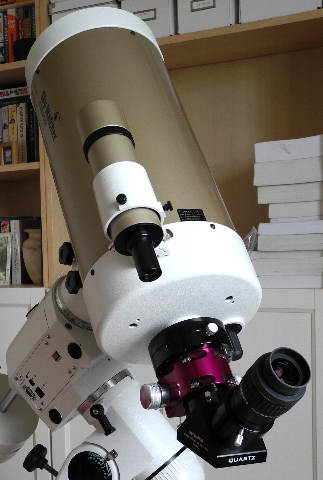 |
| The Skymax 180 Pro
with the Moonlite focuser attached. The Moonlite gave the 180 a much finer
focuser and less wobble at high magnifications. |
|
Problems
One of the issues with the Skymax 180 PRO that became
progressively more annoying was the image shift.
This is because the focuser in a Maksutov pushes on the mirror and
consequently can have the effect of moving the view as you focus. This can end
up with a kind of constant messing with the focuser or the mount to keep a
target in view and centred.
For some of the viewing
sessions where the Maksutov was being used at the upper end of its
magnification this became very distracting and I resolved to fit a rear
Crayford focuser with a 10:1 reduction for fine focusing.
This would have
the dual advantage of removing any image shift and providing a fine focus to
reduce scope wobbles at high power.
Eventually a Moonlite SCT
focuser was fitted to the rear of the scope. The original Gold Tube versions of
this scope use a conventional SCT adapter while later (Black Diamond) versions
use a different thread. With the Crayford fitted the scope really did start to
approach perfection.
As already stated some form of scope heater, or at bare
minimum, a dewshield is an absolute must for this scope as the corrector plate
at the front really act as a massive dew magnet. |
|
The Dark Night of the Soul
During summer of
2011 I became somewhat nervous regarding 'clipping' of the light cone. The
accepted wisdom amongst some fellow astronomers was that the fitting of the
visual back/Crayford focuser and the use of a 2" diagonal would cause the image
to be 'clipped' and reduce the scopes capability to that of a 5" Maksutov or
thereabouts.
Clipping occurs when the optical train is extended on
this type of scope (any form of external focuser or larger diagonal will
increase the focal length). As the length is extended the light cone coming
from the secondary mirror becomes wider and there comes a point when the length
is extended so that the widened light cone is clipped off by the diameter of
the rear portal of the telescope.
Repeated observations did
not appear to confirm this view and indeed views looked no
different whether I used the standard 1.25" diagonal connected directly to the
scope or used the external Crayford with a 2" diagonal.
A kind of telescope paranoia and hypochondria started to
etch itself into my consciousness and I started to worry that perhaps, even
after the trials and tribulations so far, the Skymax 180 PRO wasn't in fact the
scope I had always thought it was.
| Ray
Tracing................ |
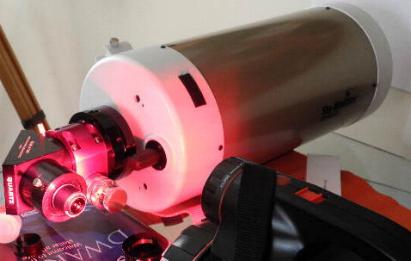 |
The scope is put square on
and close to a wall with a pale colored card attached.
A long focal length (25mm) EP is inserted and a powerful
light is shone into the eyepiece (above). Note: this is the test
being done with the Moonlite focuser in place. You need to do the test also
with just a diagonal to see if there is a change. |
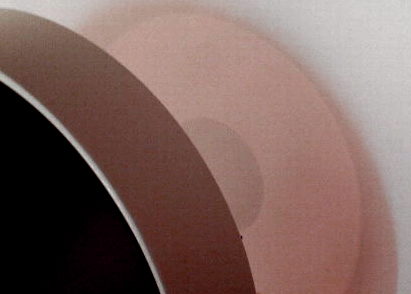 |
| The
scope will show a brighter disk against the wall or pale card. This can be
measured to give a resonably accurate aperture measurement and assess whether
the light path is constricted. |
|
Illumination
Extensive reading on the issues related to the lengthening of the
light path eventually turned up an interesting article on testing the true
aperture of a Maksutov or SCT design.
A simple test can be done by
putting a high intensity light into an eyepiece on the telescope and measuring
the size of the circle of light that the primary will project onto a wall
situated close to the front of the telescope and square to the telescope
tube.
Ideally a green laser is required but this can be done
with any large focal length eyepiece and a powerful torch. The results will not
be as accurate as an optical bench with a laser but will yield a rough guide as
the telescopes effective aperture.
My Skymax was rigged up for
testing and I found that the telescopes effective aperture is only around 170mm
not the 180mm stated by Skywatcher. This is because the telescopes corrector
plate is 180mm and the primary mirror is also 180mm. In a Maksutov the primary
mirror must always be larger than the corrector plate. Now this smaller than
stated aperture has both its ups and downs.
The downside is that the scope is somewhat smaller than stated but
the upside is that because of this aperture limiting effect by the primary
mirror the addition of an external focuser and 2" diagonal has no detrimental
effects on the telescopes performance. |
|
The ray tracing
test vindicated my observing tests. The reason I could never see a reduction in
the image quality or brightness was not down to my observing but down to the
fact that because the Skymax is already aperture limited there would be no
observable change in view by increasing its optical path. This caused me a few
moments of anxious thought as I realised my 180mm telescope was in fact a 170mm
telescope and therefore smaller than I had imagined. After a few moments though
I thought about it and realised that irrespective of the discrepancy in
aperture it still renders astounding views and consequently any theoretical
limit is meaningless.
The increase in the optical path does
though affect the focal length. The stated focal length of the Skymax 180 is
2700mm but mine is probably somewhat longer and I have estimated around 2780mm.
This has a small effect on the magnification and also increases the focal ratio
slightly. Neither have an observable effect on performance beyond the
theoretical.
Union of the Ultimate
With all doubts now set aside, a fine focuser that
doesn't introduce any image shift and the orthoscopic eyepieces which are ideal
for planetary work the Skymax at last could run to its full potential. During
Winter 2011 and Summer 2012 the Skymax showed more and more just what it could
do.
Outstanding views of planets and
some of the best views inside the Orion Nebula I have seen. Beautifully
contrasted clouds of dust around the trapezium with a finesse that's quite
breathtaking.
Lunar views on crescent
moons have been astounding and the Skymax 180 has proven to be a great
performer on almost any relatively compact astronomical body.
One of the
Skymax 180 PROs strength is its huge focal length and high focal ratio. Its
long focal length means that even relatively low power eyepieces yield large
magnifications and its high focal ratio means even the humblest of eyepieces
will perform well, it also provides very high contrast and
magnification.
Because of the long focal
length I have been able to use orthoscopic eyepieces for planetary viewing.
Normally an orthoscopic eyepiece has too tight an eye-relief at the lower focal
lengths that a non-Maksutov telescope can deliver for me. The Skymax allows me
to achieve maximum magnification using much longer focal length eyepieces of
typically 9 and 12.5mm. The combination of orthoscopic eyepieces and the big
Maksutovs focal length provides incredibly detailed and sharp images on
planetary and lunar views and high contrast images of many deep space objects
as well.
The sparkling performance of the Skymax 180 PRO on planets though is
bought at the price of its narrow field of view. This means the scope is unable
to see wide field objects like some open clusters in their full glory and by
and large is limited to 1.25" eyepieces or at least eyepieces that have a
smaller field lens than the exit portal in the telescope which is 25mm. The
limitation on open clusters and large wide field objects is more apparent than
real because there aren't in fact THAT many objects that cant fit in its field
of view and its ability with compact objects more than outweighs the drawbacks
with widefield objects in my opinion.
On
the subject of eyepieces some 2" eyepieces can be used if you can live with the
inevitable vignetting. As an example the Explore Scientific 14mm 100' EP works
acceptable well in the Skymax 180 PRO whereas the Explore Scientific 30mm 82'
does not. The 30mm displays a terrible ring of fire around the field of view
which is very distracting.
People versed in the way of
telescopes will know that no one telescope is perfect for all targets and
eyepieces and so it is with the Skymax 180 PRO. The telescope however is a
worthy addition to anyones arsenal of telescopes and especially so if planetary
viewing is one of their interests.
Summing Up
The Skymax 180 PRO is often talked about as a one trick pony good
only for planetary work - its far more than that. Its an extremely powerful and
versatile telescope for the visual observer with a planetary performance that's
probably unrivalled at its price. Its long cool down time is, in my opinion,
vastly overstated and mine is often used with less than 30 minutes cool down
time and renders very pleasing views indeed.
Its been a journey of discovery with this telescope and at times I
have come very close to selling it along the way. Its been a 3 year struggle to
tame it but the path to telescope Nirvana is not an easy one as fellow
astronomers will know. After trials and tribulations, cares and woes and many
travails and curses I have finally learned to stop worrying and love the Skymax
180 PRO Maksutov.
|